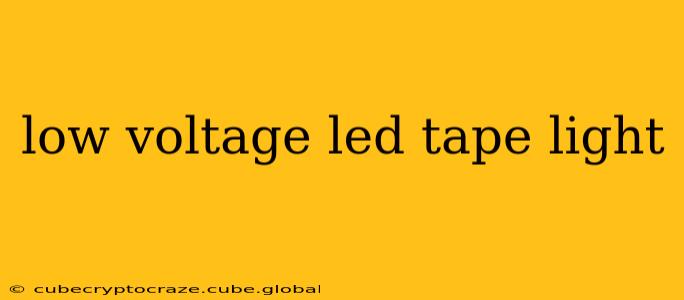Low voltage LED tape lights have revolutionized interior and exterior lighting design, offering a versatile, energy-efficient, and aesthetically pleasing solution for a wide range of applications. From accent lighting under cabinets to creating dramatic backlighting for entertainment centers, their adaptability is unmatched. This guide will delve into the specifics of low voltage LED tape lights, answering common questions and exploring their benefits and considerations.
What are Low Voltage LED Tape Lights?
Low voltage LED tape lights are flexible strips containing numerous small LEDs mounted on a printed circuit board (PCB). Unlike traditional high-voltage lighting, these operate on a lower voltage, typically 12V or 24V DC, requiring a power supply to convert standard household AC voltage. This lower voltage significantly enhances safety, especially in applications involving water or potential contact. The flexibility allows for easy installation around curves and in tight spaces, making them ideal for both DIY projects and professional installations.
What are the benefits of using low voltage LED tape lights?
The popularity of low voltage LED tape lights stems from a multitude of advantages:
- Energy Efficiency: LEDs consume significantly less energy than traditional incandescent or halogen bulbs, leading to lower electricity bills and a smaller carbon footprint.
- Long Lifespan: LEDs boast a much longer lifespan than incandescent bulbs, reducing replacement costs and maintenance.
- Flexibility and Adaptability: Their flexible design makes them ideal for various applications and installation locations.
- Low Heat Output: They generate minimal heat, making them safe for use in enclosed spaces or near flammable materials.
- Dimmability: Many low voltage LED tape lights are dimmable, allowing for customized lighting ambiance.
- Color Options: Available in a wide range of colors and color temperatures (warm white, cool white, RGB), they cater to diverse aesthetic preferences.
What is the difference between 12V and 24V LED tape lights?
The primary difference lies in the voltage they operate on. 24V systems generally allow for longer runs of LED tape before voltage drop becomes significant. This means you can illuminate larger areas with a single power supply. 12V systems are more common for smaller projects, but require more power supplies for longer runs. The choice depends on the project's scale and complexity.
How do I install low voltage LED tape lights?
Installation typically involves attaching the tape to a surface using adhesive backing, ensuring the surface is clean and dry. Connecting the power supply, controller (if dimmable), and the LED strip requires careful attention to polarity (+ and -). Consult the manufacturer's instructions for specific guidance, as methods can vary slightly depending on the product. Always ensure proper safety precautions are followed when working with electricity.
How much power do low voltage LED tape lights use?
Power consumption varies depending on the LED density (number of LEDs per meter) and the power of each LED. Always check the manufacturer's specifications for wattage per meter. This information is crucial for selecting the appropriate power supply to prevent overloading or underpowering the system.
Are low voltage LED tape lights waterproof?
Waterproof ratings vary. Some are designed for indoor use only, while others have an IP rating (Ingress Protection) indicating their resistance to water and dust. For outdoor use or applications involving moisture, it's crucial to select tape lights with an appropriate IP rating, typically IP65 or higher.
Where can I use low voltage LED tape lights?
The versatility of low voltage LED tape lights makes them suitable for a vast array of applications, including:
- Accent lighting: Under cabinets, shelves, countertops, and furniture.
- Backlighting: For televisions, artwork, and displays.
- Ambient lighting: To create a soft, diffused glow in hallways, bedrooms, or living rooms.
- Decorative lighting: To highlight architectural features or create custom lighting designs.
- Outdoor lighting: In landscaping, pathways, and architectural features (with appropriate waterproof ratings).
What kind of power supply do I need for low voltage LED tape lights?
You'll need a power supply that matches the voltage (12V or 24V) and amperage requirements of your LED strip. The amperage (measured in amps or milliamps) is crucial; an insufficient amperage will result in dimming or failure. Always select a power supply with a slightly higher amperage rating than the LED strip's requirement to ensure reliable operation.
This comprehensive guide provides a solid foundation for understanding and utilizing low voltage LED tape lights effectively. Remember to always consult the manufacturer's instructions and prioritize safety during installation.
